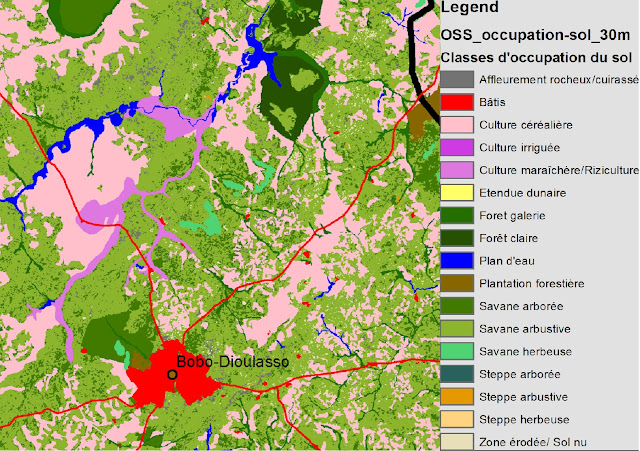The environmental trade-off model, i am working with lately, is based on the idea that feed can move within the whole study area! A strong assumption?So in the last field trip to Burkina Faso, we investigated the matter.
In fattening and dairy systems in peri-urban Burkina Faso, feed is mostly brought to the animals. Most of the feed is crop-residue, from maize, sesame, sorghum and other local crop. Most of the farmers have their own, but also buy the crop residue from their neighbor, or the buy the right to graze on the field with residue.
There is also some natural grasses that can be found on common land, but some farmers also get grass from privately owned land for which they got the usage right. Most farmers pay for these right, but we met one who got grass for free.
Next to grass and crop residue, farmers feed other local feed, from local tress but also a whole bunch of concentrates. Firstly, around Bobo-Dialassou is providing a full concentrate produced in Cote d'Ivoire at subsidized price.
Secondly, because of the area produces cotton, the cotton seed are transformed to oil. The residue of that oil production is called cotton seed cake. Though it is produced locally, the high fat content makes cotton seed cake a high value feed with a regional market. The cotton seed cake from Bobo can be found up to Mali, where the price are better.
The state company that produces oil and cotton seed cake at high quality has specific rules about cotton seed cake. Their oil is more expensive than the one of the competition. So the oil is always sold with the cotton seed cake, which can fetch a higher price. So only the one who buys the oil can get the cotton seed cake (that is of better quality than the one of the competition). So the big oil buyer will also develop a market for the cotton seed cake. Because prices are so much better in Mali, the oil buyers usually sell the cotton seed cake abroad.
In conclusion, feed moves around quite a bit within the study area but also move out of the study area for animals in drier locations such as Mali.
In fattening and dairy systems in peri-urban Burkina Faso, feed is mostly brought to the animals. Most of the feed is crop-residue, from maize, sesame, sorghum and other local crop. Most of the farmers have their own, but also buy the crop residue from their neighbor, or the buy the right to graze on the field with residue.
 |
| maize residues prepared for sale to the neighbor |
 |
| Natural grass dried and stored for the dry season |
 |
| The concentrate from Cote d'Ivoire |
Secondly, because of the area produces cotton, the cotton seed are transformed to oil. The residue of that oil production is called cotton seed cake. Though it is produced locally, the high fat content makes cotton seed cake a high value feed with a regional market. The cotton seed cake from Bobo can be found up to Mali, where the price are better.
 |
| Sesame ready for seed extraction, afterwards the residue is fed to animals |
The state company that produces oil and cotton seed cake at high quality has specific rules about cotton seed cake. Their oil is more expensive than the one of the competition. So the oil is always sold with the cotton seed cake, which can fetch a higher price. So only the one who buys the oil can get the cotton seed cake (that is of better quality than the one of the competition). So the big oil buyer will also develop a market for the cotton seed cake. Because prices are so much better in Mali, the oil buyers usually sell the cotton seed cake abroad.
 |
| Cotton seed cake from the state company (left) |
 |
| Cotton seed cake from the local companies |
In conclusion, feed moves around quite a bit within the study area but also move out of the study area for animals in drier locations such as Mali.
 |
| Moving feed out of the study area |













